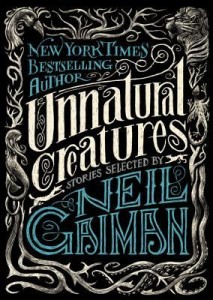Take Notes On Stories You Don’t Like: Inksplot edition
 Inksplot is the first story in Unnatural Creatures, an anthology curated/edited by Neil Gaiman and Maria Dahvana Headley. Warning: mild spoilers contained in this post.
Inksplot is the first story in Unnatural Creatures, an anthology curated/edited by Neil Gaiman and Maria Dahvana Headley. Warning: mild spoilers contained in this post.
Stories told in second person, where the narrator is talking to the reader and is a character in the story being told bother me. I read to escape and a second person narrator often feels like a guide elbowing me to point out stuff they find cool. I’d rather have an unseen narrator telling me about an ornate room that smells of Egyptian cotton and furniture polish, with a fireplace that looks unused because the master of the house, Archer, would never want anything as unclean as a used-looking fireplace than a narrator saying, “Imagine a beautiful room, exquisitely furnished, impeccably maintained. Imagine the occupant of that room to be a thin, tallish gentleman, dressed faultlessly, in the best possible taste. Conceive of the whole thing, man and room in combination, to be a flawless example of the sort of styled perfection that only large amounts of money, filtered through generations of confident privilege, can produce.” I like to use my imagination without being directed to use my imagination. Tell me about the world, don’t tell me what to do.
Oral tales that have been committed to paper, like Tolkien’s Hobbit and Lord of the Rings series, can work well if that’s the vibe you’re going for. The narrator is a minor character that butts in every so often with something useful and the whole story has this feel that it’s been handed down from generation to generation and has been recorded on paper to keep the story alive. On the other hand this story feels like it’s being told over a few beers, which might be the intention.
Storytelling can be taught by things you like and things you don’t, like I said in the NOS4A2 post. I did appreciate how well I knew the three characters from their sparse descriptions. Archer, the master of the house, is a bachelor from a wealthy family who likes everything just so. Faulks, Archer’s butler, is a lot like his master except for the wealthy family part. Sir Harry Mandifer is a smug, large man who is wealthy, but by his own ventures. The fourth character, Inksplot, is a bit like a Weeping Angel from Doctor Who— doesn’t say much and moves when no one is looking. A lot of the different elements of the story that annoyed me, like the character disappearing offscreen, the repetition (a good example being where Archer first sees Inksplot, “in its simplicity” without “the slightest complication or involvement” nor “the tiniest, the remotest, the most insignificant trace of embellishment”), and the ever-present narrator, gives the story a gossipy feel that can make a horror story feel closer and therefore creepier. However the distraction from the narrator overshadows any fear I might feel about Inksplot appearing and disappearing me, which is ultimately what makes me not like the story: unsatisfactory ending.
